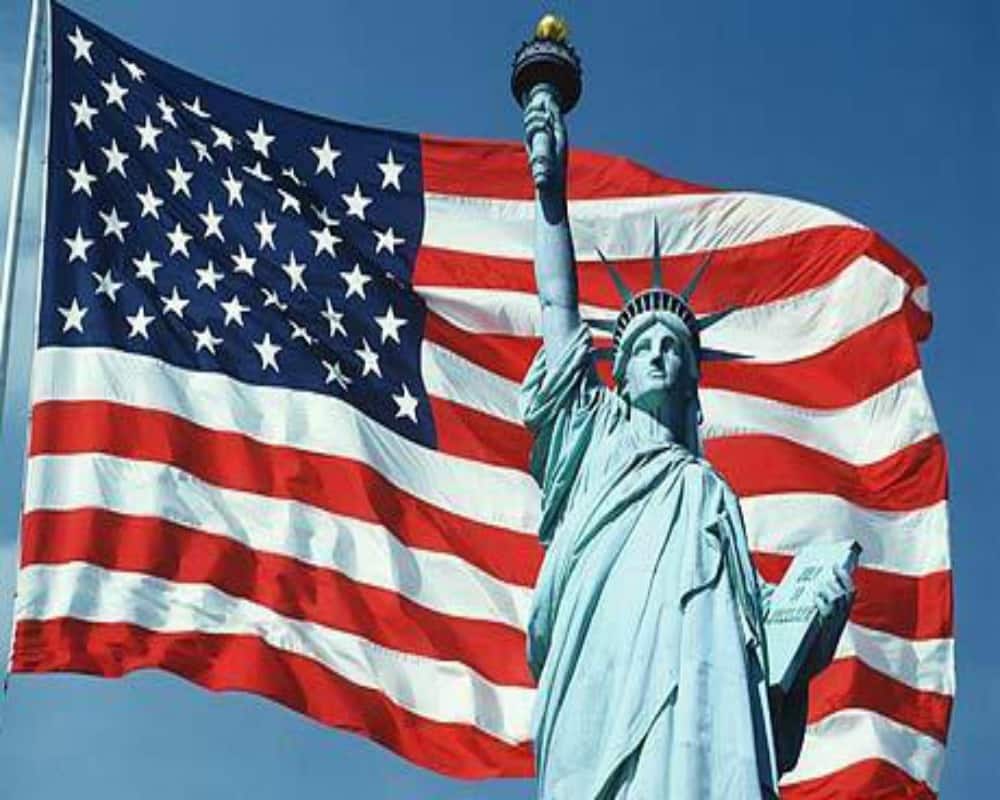The United States Flag Code says:
The Pledge of Allegiance to the Flag:
"I pledge allegiance to the Flag of the United States of America, and to the Republic for which it stands, one Nation under God, indivisible, with liberty and justice for all."
The Pledge of Allegiance of the United States is an expression of allegiance to the flag of the United States and the republic of the United States of America. Such a pledge was first composed, with a text different from the one used at present, by Captain George Thatcher Balch, a Union Army Officer during the Civil War and later a teacher of patriotism in New York City schools. The form of the pledge used today was largely devised by Francis Bellamy in 1892, and formally adopted by Congress as the pledge in 1942. The official name of The Pledge of Allegiance was adopted in 1945. The most recent alteration of its wording came on Flag Day in 1954, when the words "under God" were added.
The Pledge of Allegiance of the United States is an expression of allegiance to the flag of the United States and the republic of the United States of America. Such a pledge was first composed, with a text different from the one used at present, by Captain George Thatcher Balch, a Union Army Officer during the Civil War and later a teacher of patriotism in New York City schools. The form of the pledge used today was largely devised by Francis Bellamy in 1892, and formally adopted by Congress as the pledge in 1942. The official name of The Pledge of Allegiance was adopted in 1945. The most recent alteration of its wording came on Flag Day in 1954, when the words "under God" were added.
Recital
Congressional sessions open with the recital of the Pledge, as do many government meetings at local levels, and meetings held by many private organizations. All states except California, Hawaii, Iowa, Vermont, and Wyoming require a regularly scheduled recitation of the pledge in public schools. California requires a "patriotic exercise" every day, which would be satisfied by the Pledge, but it is not universally enforced. The Supreme Court has ruled in West Virginia State Board of Education v. Barnette that students cannot be compelled to recite the Pledge, nor can they be punished for not doing so. In a number of states, state flag pledges of allegiance are required to be recited after this.
History
https://www.va.gov/opa/publications/celebrate/pledge.pdf
Thirty-one words which affirm the values and freedom that the American flag represents are recited while facing the flag as a pledge of Americans’ loyalty to their country. The Pledge of Allegiance was written for the 400th anniversary, in 1892, of the discovery of America. A national committee of educators and civic leaders planned a public-school celebration of Columbus Day to center around the flag. Included with the script for ceremonies that would culminate in raising of the flag was the pledge. So it was in October 1892 Columbus Day programs that school children across the country first recited the Pledge of Allegiance this way: I pledge allegiance to my Flag and to the Republic for which it stands: one Nation indivisible, with Liberty and Justice for all. Controversy continues over whether the author was the chairman of the committee, Francis Bellamy — who worked on a magazine for young people that published the pledge — or James Upham, who worked for the publishing firm that produced the magazine. The pledge was published anonymously in the magazine and was not copyrighted. According to some accounts of Bellamy as author, he decided to write a pledge of allegiance, rather than a salute, because it was a stronger expression of loyalty — something particularly significant even 27 years after the Civil War ended. “One Nation indivisible” referred to the outcome of the Civil War, and “Liberty and Justice for all” expressed the ideals of the Declaration of Independence.
I pledge allegiance to my Flag and
to the Republic for which it stands:
one Nation indivisible, with Liberty
and Justice for all.
Congressional sessions open with the recital of the Pledge, as do many government meetings at local levels, and meetings held by many private organizations. All states except California, Hawaii, Iowa, Vermont, and Wyoming require a regularly scheduled recitation of the pledge in public schools. California requires a "patriotic exercise" every day, which would be satisfied by the Pledge, but it is not universally enforced. The Supreme Court has ruled in West Virginia State Board of Education v. Barnette that students cannot be compelled to recite the Pledge, nor can they be punished for not doing so. In a number of states, state flag pledges of allegiance are required to be recited after this.
The United States Flag Code says:



No comments:
Post a Comment